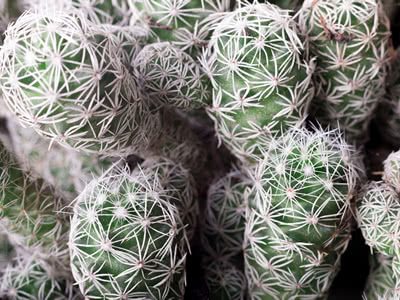The Mammillaria vetula, formerly known as Mammillaria gracilis, and popularly called the thimble cactus, is a compact succulent native to semi-arid regions of Mexico and Central America. The thimble cactus features a stem known as a cladode, which is columnar, cylindrical, and rounded at the top. The green color of the stem contrasts with the intertwined white spines, resembling lace and being harmless to touch. At the top, the spines are longer, harder, and brown in color.
This cactus forms dense, flattened clusters that develop through lateral shoots originating from the initial cladode. These shoots spread across the ground, but the connection between the cladodes is very fragile and easily breaks upon touch. Therefore, when handling the plant, care should be taken not to touch the cladodes. During the summer and autumn, the thimble cactus produces small and charming yellow flowers.

Its growth is slow, making it a highly prized species among collectors. Although not rare, it is challenging to find large, united plants because their fragility makes it easy to separate the cladodes. Cultivation requires patience and care to keep the plants together in a pot.
For optimal cultivation, the thimble cactus should be placed in full sun or partial shade, in a substrate suitable for cacti and succulents. This substrate should be well-draining and rich in minerals. Watering should be spaced out, moistening the substrate until it dries completely before the next watering. Shallow pots without a saucer, preferably made of plastic, are recommended to facilitate drainage. The plant can also be grown indoors, provided it is placed near a window that receives direct sunlight, preferably facing north, east, or west.
It is important to avoid excess moisture, as this can cause rotting and the death of the plant. The thimble cactus tolerates drought and extreme temperatures, including down to -4°C (24°F), but it should be protected from frost. Also, avoid exposure to strong vibrations, such as heavy rains or bumps, which can separate the cladodes. Plant propagation is easily done by separating the segments (cladodes), which detach easily. These should be placed for rooting while maintaining their original position. Multiplication by seeds is also possible, although it is a bit slower. Sow them in seed trays to maintain constant moisture. Seed germination is relatively quick, but the initial development of the plants is slow.

